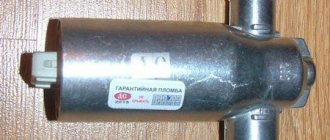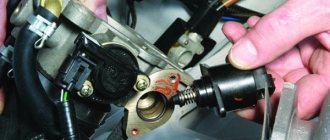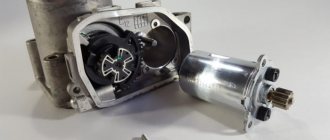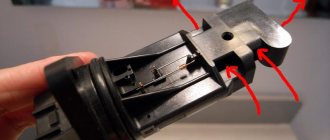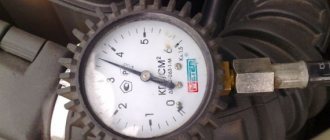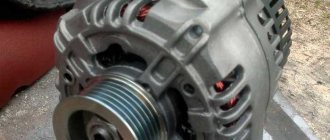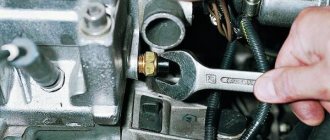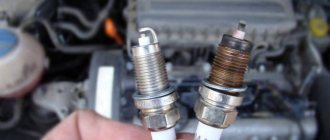A small idle air valve, often called the idle air control valve (IAC), located inside your vehicle's throttle body, helps keep the engine idling smoothly.
Idle speed control disassembled
The principle of operation of the idle speed sensor is to regulate the amount of air entering the engine when the engine is idling. Proper engine idle speed is vital to the economy and safety of engine parts. Idle system When starting the vehicle, a cold engine will require more air to idle smoothly. Additionally, when you step on the gas and then release it, the air supply to the engine is cut off. But in order for the engine not to stop, some air must be supplied to the engine. From the above cases it is clear that air control is vital for the smooth running of the engine. At the same time, you should control the amount of air entering your car's engine, otherwise the engine will end up with more air than fuel.
Most idle air control valves take the form of a motorized valve or motor mounted somewhere on the vehicle's intake manifold. The valve or motor is controlled by the engine control module, which adjusts idle speed based on parameters such as engine temperature and electrical system load.
More details about the principle of operation of the sensor in the video:
Where is the idle speed sensor located?
The location of the sensor may vary slightly depending on the make of your car. In order not to describe for a long time, it is best to understand where the idle speed sensor is located, it is better to look at the picture below.
Typically, a bad or faulty idle air control valve will cause several symptoms that alert the driver to a potential problem:
- Irregular idle speed
One of the most common symptoms associated with a problematic idle air control valve is an irregular idle speed. The idle air control valve is programmed to regulate and maintain a constant engine idle speed. If the valve fails or has any problems, it can cause the idle speed to reset. This can result in an unusually high or low idle speed or, in some cases, a high idle speed that continually rises and falls.
- Check if the engine light comes on
Another sign of a potential problem with the idle air control valve is the check engine light coming on. If the engine control module detects a problem with the idle air control valve circuit or signal, it will turn off the check engine light to notify the driver that there is a problem. The Check Engine Light can also turn off due to a variety of problems, so it is recommended that you check your vehicle's computer for trouble codes.
- The engine stalls
Another more serious sign of an idle air control valve problem is the engine stopping completely. If the idle air control valve fails completely, it may leave the vehicle because there will be no air source to maintain a proper idle. This can cause the engine to stall while running, and in some cases can cause the engine to not idle at all and stall when starting.
If your car has any of the symptoms listed above, or you suspect that your idle air control valve may have a problem, it is better to contact a specialist or check it yourself, more about checking the idle air control valve below.
Advice
If the engine speed is too high, too low, or too short, the problem may not be with the idle control system, but with engine leakage. First, check your vehicle for vacuum leaks to rule out this possibility.
Diagnostics and troubleshooting
The regulator is mounted on the throttle assembly using two screws. In order to unfasten the device, you need to unscrew the bolts with a suitable screwdriver. Problems with how to remove the sensor arise if the car manufacturer filled the threaded connection with glue to prevent self-loosening of the screws from vibration. To disassemble this mount, careful steps are required to get rid of the fixing compound without damaging the throttle mechanism. It is better to remove the entire assembly for dismantling.
The idle speed sensor most often does not work due to:
- the regulator has a worn cone needle or the stepper motor or related elements have failed;
- surface contamination;
- The wiring inside the device is damaged.
To check the electrical component, it is not necessary to have an idle air control tester. To carry out diagnostics, a multimeter is sufficient. Initially, you should check the voltage supply to the contacts by setting the measurement limit to 20 V DC voltage. After this, you should disconnect the sensor and check the resistance. Between AB and CD it should be about 50 ohms. In other combinations, the multimeter should show a gap. The test scheme may change, so in order to more accurately dial the idle speed sensor, it is recommended to refer to its datasheet.
If there is contamination, the idle air regulator will need to be cleaned. Before starting the procedure, it is worth visually inspecting the valve for the presence of foreign particles. Next, you need to adhere to the following recommendations on how to clean the RX with your own hands:
- for cleaning, use WD-40 penetrating lubricant, or the liquid that is used to flush the injector;
- During the cleaning process, constantly monitor how the valve operates;
- Avoid excessive force that could cause deformation.
Repair is not appropriate if there is damage or excessive wear to the stepper motor, taper needle, or rod. In this case, we change the pxx to a new one.
Recognizing idle problems
- When there is a vacuum leak, the idle air valve is usually fully extended (closed position). Basically, this means that there is an air leak in the engine and the engine computer is trying to lower the idle speed by shorting the idle air circuit. If an open or closed circuit in the idle air control valve, drive circuit, or idle speed is out of range, one or more DTCs will usually set and the indicator will illuminate. When the light is on, you need to connect a scan tool to the diagnostic port and read the codes that set the light.
- Electric vehicles typically do not have an idle air control valve, as the computer receives information from all the sensors and automatically adjusts the throttle angle as needed. An idle fault may require cleaning or replacing the throttle body and using a professional scan tool to reset the system.
Necessary materials
- digital universal measuring instrument
- Professional automotive scanner
- Hints
- Throttle body/intake filter
- Vehicle Maintenance Manual
Warning
The difference between throttle body cleaner and brake cleaner is that the throttle body contains some lubricant for the moving components of the throttle body. DO NOT use throttle body cleaner on the brake system.
Subtleties of purchasing a new IAC
After purchasing a new regulator, you need to configure it. The injector calibrates itself using the computer, so there will be no difficulties with how to change the sensor. To perform the operation automatically, it is enough to de-energize the injector before installing the IAC.
When purchasing a new regulator, you should pay attention to its quality. The valve and other elements must not have any defects or deformations. The quality of contact soldering must be at a high level. Installation on the seat must occur without distortions, otherwise repairs will soon be required.
The air flow passing through the valve solved the issue of engine operation without load. Now the throttle valve is entrusted with the function of controlling dynamic characteristics, and at idle speed the engine is in full control of the rxx. The ability of the sensor to increase speed allows the car owner not to waste time waiting for the engine to warm up.
Checking pxx by disconnecting
Step 1: Accessing the Idle Air Control Valve . For information about the position of the idle air valve on your vehicle, refer to your vehicle's service manual.
Step 2: Disconnect the idle air valve . Locate the idle air valve electrical connection and disconnect the valve.
Step 3: Start the engine . Start the engine and see how the car reacts. If the vehicle may have stalled after starting the engine, turning off the valve will open the bypass circuit and allow the vehicle to idle while the valve is turned off.
Step 4: Connect the valve . Turn off the ignition and reconnect the idle air valve electrical connector.
Step 5: Start the engine . At this point, the engine idle should return to normal. If so, the valve may be operating correctly. If not, use the following method to check if it needs cleaning.
Visual inspection and cleaning of the idle air regulator and valve
Step 1: Valve Access . For information about the position of the IAC valve on your vehicle, refer to your vehicle's service manual.
Step 2: Disconnect the valve . Locate the valve's electrical connection and disconnect the idle air valve.
Step 3: Remove the valve from the car . Use the procedure described in your vehicle's service manual to remove the valve.
Step 4: Check the idle air valve . Inspect the valve and mounting location for carbon deposits, rust, or dirt. Check the valve pin and mounting location for damage.
Step 5: Clean the valve and bypass . Use carbon cleaner or intake cleaner solvent to remove debris and dirt from the valve. Use the straw provided with the aerosol can to clean the valve area and bypass.
Warning . Do not use metal wire brushes to clean the valve or bypass circuit. Cleaning the walls or pegs with a wire brush may change the function of the valve.
Step 6: Install the valve . Install the valve with a NEW gasket. Using an old seal may result in a vacuum leak or loss of coolant on vehicles with coolant leaking through the valve.
Step 7: Start the engine . If you have used a lot of solvents, the engine may run rough in a short time as it picks up the solvent and burns. After a short period of rough running, the idle speed should return to normal.
Purpose, device and principle of operation
The main components of the idle air control sensor include a cone needle, a stepper motor, a spring and a rod. You can see the insides of the pxx in the image below.
The conical needle is used to change the throughput of the regulator. which affects the amount of air supplied to the engine. The spring is used to create counteraction and eliminate backlash in the operation of the sensor. The stepper motor acts as a drive. Control signals are generated in the ECU, taking into account information from other sensors, for example, the position of the crankshaft or coolant temperature.
The principle of operation of the device is based on changing the cross-section of the air flow channel going into the combustion chamber when the throttle is locked. The stepper motor extends the rod until the tapered needle touches the hole. When you start the machine, the PHH opens the passage, supplying the required amount of air. For a better understanding of the principle of operation of the idle air regulator, you should pay attention to the cross-section of the idle air control shown below.
The operation of the regulator allows for accelerated warming up of the car. When the coolant sensor signals that the engine is operating below the permissible temperature range, the amount of air supplied automatically increases. As a result, the crankshaft speed increases and heating occurs more intensely. Thanks to the pxx injector, you can drive the car immediately after starting the engine, which is not available to owners of carburetor engines.
The pxx is located near the throttle sensor. The stepper motor cover stands out strongly against the background of the assembly. The difficulty of finding where the regulator is located only arises if it is located under a common plastic casing that protects the devices from mechanical damage.
Using a Multimeter to Check Valve Resistance Specification
Step 1: Access to the XX valve . For information about the valve position on your vehicle, refer to your vehicle's service manual.
Step 2: Disconnect the valve . Locate the valve's electrical connection and disconnect the idle air valve.
Step 3: Remove the valve from the car . Use the procedure described in your vehicle's service manual to remove the valve.
Step 4: Check the valve . Inspect the valve and mounting location for carbon deposits, rust, or dirt. Check the valve pin and mounting location for damage. Correct these problems before condemning the valve.
Step 5: Check valve resistance . Use the specifications listed in the vehicle's Service Manual for the idle air valve and follow the directions for testing the valve using a digital multimeter on the electrical contacts of the valve's electrical connector. If the value is within specification, the valve should sound as it did, which means the error is elsewhere. If the readings are not within specifications, replace the device with a new one.
Note
The new idle air valve may or may not come with a new gasket. Remember to replace the gasket every time the sealed part is removed from the engine to avoid vacuum leaks or coolant leaks when coolant leaks through the valve body.
